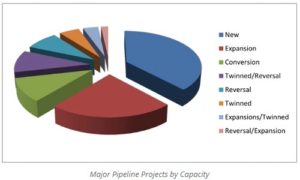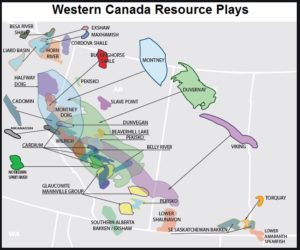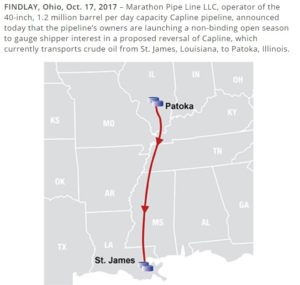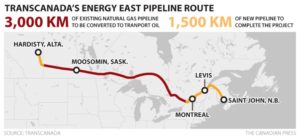 What happens to oil pipelines in a post oil world? Many people think the massive expenditures in pipelines result in a permanent oil infrastructure. The fact is that pipelines originally constructed to move oil are both reversed and repurposed all the time.
What happens to oil pipelines in a post oil world? Many people think the massive expenditures in pipelines result in a permanent oil infrastructure. The fact is that pipelines originally constructed to move oil are both reversed and repurposed all the time.
The graphic to the right is from 2014 and shows that oil pipeline reversals and repurposing are not new.
Here are some real world examples about what happens to old oil/gas pipelines.
PIPELINE REVERSALS:
- Enbridge ‘Line 9’ reversed the flow on 639 kilometers of oil pipeline from Hamilton Ontario to Montreal Quebec in 2015
- TransCanada (now TC) ‘Energy East’ pipleline would both repurpose hundreds of kilometers of Natural Gas line into an Oil line flowing in the other direction through Ontario
- Marathon is reversing their ‘Capline’ pipleline from Illionois to the Louisiana coast right now
- Enbridge ‘Southern Lights’ pipeline is changing from crude oil to diluent and reversing the flow on hundreds of kilometers between Regina and Chicago
OIL PIPELINE ALTERNATE USES:
- Many oil and gas pipelines will be used to move ultraclean hydrogen
To be clear “…Converting natural gas pipelines to carry a blend of natural gas and hydrogen (up to about 15% hydrogen) may require only modest modifications to the pipeline. Converting existing natural gas pipelines to deliver pure hydrogen may require more substantial modifications. Current research and analyses are examining both approaches.” SOURCE: Energy.gov - TransMountain TMX Pipeline transports thin gasoline, thick bitumen (oil sands), diesel, and even synthetic crude on different days or the week
- Williams converted almost 2000 kilometers of oil pipeline into conduit to run fiber optic cable
- Tennessee Gas Pipeline has applied to change its current gas pipeline to to carry Natural Gas Liquids (NGL)
- “…They can be used for transportation of water. Oil pipeline (up to 28″ inches) are comparatively smaller than Gas pipelines (up to 52″ inches). Pipeline are… often being long & have huge volume, it can also be used as liquid storage.” SOURCE: quora.com/What-else-can-oil-pipelines-be-used-for-when-theyre-done-with-oil
Can Oil Pipelines Be Used To Decarbon The Earth?
 Today, new pipelines are being constructed to transport CO2 back to the Bakken and Williston basins (in Alberta and Saskatchewan) where oil and gas are currently drawn from:
Today, new pipelines are being constructed to transport CO2 back to the Bakken and Williston basins (in Alberta and Saskatchewan) where oil and gas are currently drawn from:
“…The Alberta Carbon Trunk Line, when completed, will be the world’s largest CO2 pipeline. The 240-kilometre pipeline will collect captured CO2 from a fertilizer plant and the new Sturgeon Refinery near Edmonton, and pipe it to mature conventional oilfields near Clive, Alberta.”
SOURCE: alaskahighwaynews.ca/business/world-s-largest-carbon-sequestering-pipeline-is-being-built-in-alberta-1.23785172
In the future existing oil and gas pipelines will be reversed and used to transport CO2 from industrial emitters to places like Alberta that have ideal CO2 storage geology in the not so distant future.
“..This paper shows that reuse of pipelines for use with dense phase or supercritical CO2 can be carried out.
SOURCE: 2011 – Pipeline Technology Conference
OTHER OPTIONS FOR OIL & GAS PIPELINES:
“…Europe Stores Electricity in Gas Pipes: Moving renewable hydrogen and methane via natural gas pipelines promises to cut the cost of switching to renewable energy
SOURCE: April 2019 – scientificamerican.com/article/europe-stores-electricity-in-gas-pipes/
.
“Pretty much whatever you can think of has been transported through a pipeline,” Vaezi said. His research found examples of pipelines moving coal, gold slime, limestone, iron ore and even wood chips.
SOURCE: cbc.ca/news/canada/edmonton/pipeline-technology-1.5281589
.
“…An additional 30-mile section of this line was recovered and shipped to Vietnam to be used as a water transportation pipeline near what is now Ho Chi Minh City. It will probably be used there for another forty years.
SOURCE: pipelineequities.com/how-to-recycle-pipeline.php
.
“…In 2008, our company took up a 6 5/8” diameter line in Central Louisiana that had been in gas service for nine years. The field depleted and the landowner who was using the land for timber wanted the pipeline removed so as to use the right of way to plant more trees. We took up the line, transported it to the CPS yard in Houston where workers cleaned the paraffin out of the interior of the pipe, straighten where needed and removed the fusion bond epoxy coating off of the exterior. We then beveled the ends and sent the pipe on to a recoating yard and it is now in service as a gas transmission line in Oklahoma. Even with all of these steps, the customer saved thirty per cent off of new pipe prices.
SOURCE: pipelineequities.com/how-to-recycle-pipeline.php
.
“…From oil to beer: How pipeline technology could change the food industry …In Bruges, Belgium, for example, as much as 6,000 litres of beer per hour is pumped through a 3.2-kilometre underground pipeline that stretches from the centuries-old De Halve Maan brewery and restaurant to its new bottling plant outside of town.”
SOURCE: cbc.ca/news/canada/edmonton/pipeline-technology-1.5281589
How Easy Is It To Repurpose an Oil Pipleline?
Changing an oil/gas pipeline to transport a different material is common enough that there are estabilished protocols. Typically reversing and/or converting an oil pipeline involves:
- modifying the existing pumping system, especically if the line is being reversed
- cleaning the the pipeline with a “PIG” (aka Pipeline Intervention Gadget)
- inspecting / repairing the pipeline with a “PIG”
- hydrotesting the pipeline at presure to re-validate the lines integrity
CONCLUSION:
The notion that new oil pipelines are a sunk cost forever emboldening the oil industry, is simply incorrect. Pipeline companies like Enbridge and TC are well aware that the end of large scale oil exploration will directly affect their businesses. They are not investing hundreds of billions of dollars into pipelines that will last 75 to 100 years without knowing that infrastructure can be readily repurposed.
Instead of thinking of pipelines as single use systems like high-voltage transmission tower corridors, think of them as paved highways. Today they can move oil, tomorrow they push hydrogen, later the will transport natural gas, and in dry places like Alberta and Montana they will eventually pump water from the coast.







2 Comments
CCray · October 10, 2021 at 5:15 am
wonderful submit, very informative. I ponder why the opposite experts of the pipeline / energy sector don’t understand this.
Robby J · March 26, 2024 at 8:17 am
It’s certainly good to know that what started as an oil pipeline can be used in many other ways, and for many other things from transporting beer to wood. I didn’t know that the flow in a a pipeline could be reversed, Even though I suppose that’s obvious, I just had never thought about it before. Also knowing that you can put water through today, oil through five years from now and then hydrogen can be piped in the other direction 10 years after that is certainly useful. Thanks!